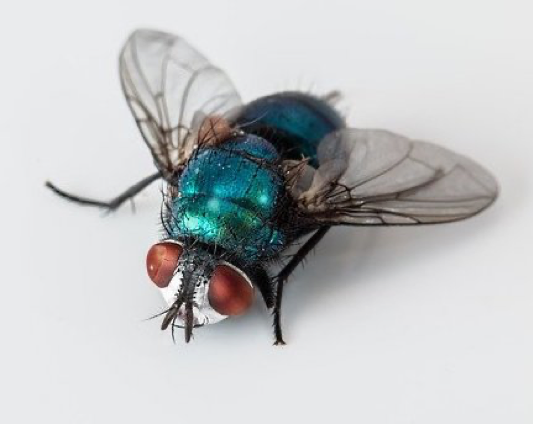FIND YOUR LOCAL
HUGHES SERVICE CENTER
Calliphoridae
Blow flies are known by several names, including carrion flies, bluebottles, greenbottles, or cluster flies. The name “blow fly” comes from an older English term for meat that had eggs laid on it, which was said to be fly blown.

| Color | Shiny with metallic coloring, often with blue, green, or black thoraces and abdomens. |
| Legs | 6 |
| Shape | |
| Size | 8-10 mm (0.3-0.4 inch) |
| Antennae | True |
Blow and bottle flies are found worldwide, occurring in almost every place occupied by people. They are one of the most common flies found around dead animals and are often discovered near meat processing plants and garbage dumps. Blow flies can enter homes through any gaps and openings but usually won’t enter a home unless there’s a food source. Finding them inside a home is usually an indicator of another deceased pest or of a nearby rodent infestation.
Blow flies are larger flies known for their metallic bluish-green color. Their larvae, also known as maggots, measure 9 to 22 mm in length. They are also soft and appear similar to tiny worms or grains of rice.
Blow flies eat decaying meat because it is essential for larval survival and growth. They are also attracted to plants that give off the smell of rotting meat since they can be a pollinator for those plants.
The lifecycle of blow flies is short, lasting about 3-4 weeks. Egg incubation time is 4 to 5 days and larvae complete their development between 4 and 10 days.
First, locate the food source attracting the blow flies, since this may also be a breeding place for these insects. Next, remove the source and clean the area thoroughly. Contact Hughes Exterminators for persistent blow fly infestations.
Blow flies do not bite humans. However, they can pose dangerous health threats to humans and animals. Blow flies land on feces, dead animals, garbage, and other decaying organic matter, which oftentimes leads to carrying around dangerous bacteria and parasites with them. As they travel around your home, landing on various surfaces, they can spread these harmful bacteria. Maggots can infest living animals, resulting in a parasitic condition known as myiasis.
After you submit the information below, a trained professional in your area will get in touch within 1-2 business days to set up a date & time that is convenient for you.